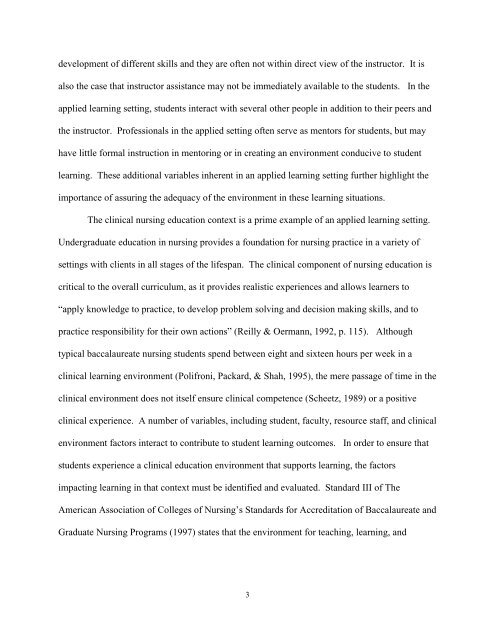STUDENT EVALUATION OF CLINICAL EDUCATION ENVIRONMENT
STUDENT EVALUATION OF CLINICAL EDUCATION ENVIRONMENT
STUDENT EVALUATION OF CLINICAL EDUCATION ENVIRONMENT
Create successful ePaper yourself
Turn your PDF publications into a flip-book with our unique Google optimized e-Paper software.
development of different skills and they are often not within direct view of the instructor. It is<br />
also the case that instructor assistance may not be immediately available to the students. In the<br />
applied learning setting, students interact with several other people in addition to their peers and<br />
the instructor. Professionals in the applied setting often serve as mentors for students, but may<br />
have little formal instruction in mentoring or in creating an environment conducive to student<br />
learning. These additional variables inherent in an applied learning setting further highlight the<br />
importance of assuring the adequacy of the environment in these learning situations.<br />
The clinical nursing education context is a prime example of an applied learning setting.<br />
Undergraduate education in nursing provides a foundation for nursing practice in a variety of<br />
settings with clients in all stages of the lifespan. The clinical component of nursing education is<br />
critical to the overall curriculum, as it provides realistic experiences and allows learners to<br />
“apply knowledge to practice, to develop problem solving and decision making skills, and to<br />
practice responsibility for their own actions” (Reilly & Oermann, 1992, p. 115). Although<br />
typical baccalaureate nursing students spend between eight and sixteen hours per week in a<br />
clinical learning environment (Polifroni, Packard, & Shah, 1995), the mere passage of time in the<br />
clinical environment does not itself ensure clinical competence (Scheetz, 1989) or a positive<br />
clinical experience. A number of variables, including student, faculty, resource staff, and clinical<br />
environment factors interact to contribute to student learning outcomes. In order to ensure that<br />
students experience a clinical education environment that supports learning, the factors<br />
impacting learning in that context must be identified and evaluated. Standard III of The<br />
American Association of Colleges of Nursing’s Standards for Accreditation of Baccalaureate and<br />
Graduate Nursing Programs (1997) states that the environment for teaching, learning, and<br />
3












